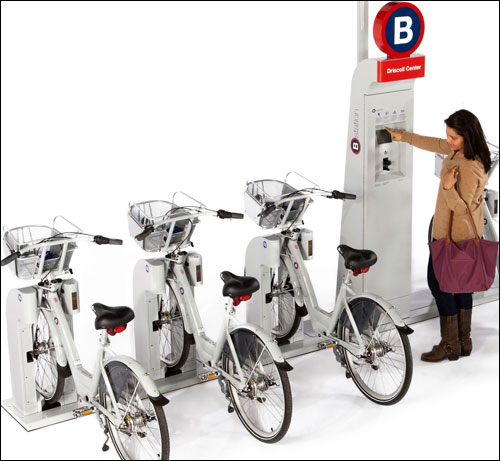In cities around the world, bike-sharing programs have cropped up in recent years as a means of providing commuters and tourists in urban corridors with a convenient, zero-emissions transportation alternative (see Bike Rental Program Peddles Smart Cards and Montreal RFID-enabled Bike Project Picks Up Speed for examples in Lyon, France, and Quebec, Canada, respectively). Last month, Denver became the latest city to embrace this trend, launching Denver B-cycle, the largest bike-sharing program in the United States, with 500 bikes available through more than 50 RFID-enabled bike stations (B-stations) throughout the city.
The B-stations, supplied by Kiosk Information Systems, include locking bicycle racks and a kiosk similar to an automated teller machine. The bikes, made by Wisconsin-based Trek, are secured via a rack’s locking docks. A station might contain as few as five locking docks, or as many as 25. The quantity of docks at each station is determined by the amount of traffic that B-cycle expects the stations to receive throughout the day. Generally, it keeps an average of 1.5 locking docks per bike. Users can access a bicycle in one of two ways. Infrequent users can utilize a credit card to purchase a short-term, 24-hour membership at a bike station’s kiosk. This allows an individual to select a bicycle and, once the transaction is complete, remove it from the rack, with a beep and a green light indicating the selected bike is unlocked and available for use.

Alternatively, those planning to use a B-cycle on a regular basis can purchase a 7-day, 30-day or annual membership online (not at a station kiosk). Those who purchase such memberships receive an RFID card, called a B-card, in the mail. They can then use that card to retrieve any available bike from a station, with the added bonus that they can skip the kiosk and go directly to the bicycle and unlock it.
“We think of the B-card as a FasTrak for bikes,” says Andrew Davison, the chief marketing officer for B-cycle LLC, referring to the RFID-based electronic toll-collection system used in California. “Imagine a busy [station] with 25-plus bikes, and a line of people waiting at the kiosk.” The card system, he says, makes the process of obtaining a bicycle considerably faster than using the kiosk.
B-cycle LLC is a national organization formed through a partnership between health insurance company Humana, Trek and ad firm Crispin Porter + Bogusky, to develop the technology and business systems used for Denver’s program, run by a nonprofit organization known as Denver Bike Sharing. B-cycle LLC is also working with other cities and countries worldwide, to launch similar bike-sharing programs that may or may not carry the B-cycle name.
The cards are supplied by Synometrix. Each contains a passive low-frequency (LF) RFID inlay, operating at 125 kHz and compliant with the protocol used by EM Microelectronic‘s EM4100, EM4102 and EM4200 RFID chips. To unlock a bike, a user approaches the station and presses a button next to the bicycle he or she wants to use. This activates the RFID interrogator embedded in the rack (each docking position on the rack comes with its own reader). The user holds the card up to a placard next to the button, and the interrogator collects the unique identification number encoded to the tag’s memory. It then forwards this information to a central B-cycle database, via the station’s Internet link. If the user’s account associated with that ID number is in good standing, the main database instructs the B-station to release the lock securing the selected bike. At the same time, the individual receives an audible alert that the bicycle is unlocked. and a green light next to the bike flashes. The user then has 30 seconds to remove the bike before the lock reengages.
Regardless of whether the user obtains a bicycle via a credit card or a B-card, before the bike is removed, the reader also collects the ID number encoded to a similar RFID tag attached to the bike. The device then forwards this number to the central database, so that the system knows which particular bike to associate with which user.
To return a bicycle, the user simply finds an empty locking dock at any B-station and rolls the bike into the locking position. A green light again flashes, and an audio signal lets that person know that the bike has been secured and his or her account has been updated to reflect that status. Once the bicycle is returned, the reader collects the tag ID from the bike’s tag and sends this information to the database.
Embedded in each bike is a GPS unit that records the routes that a user travels. When a user returns his or her bicycle to a B-station, the GPS information is uploaded to the database, along with that bike’s tag ID number. This, Davison says, helps Denver B-cycle understand the most common routes that its members take. He also hopes to be able to utilize this data to begin working with Denver merchants to target product or service offerings to members, based on their daily routes. For example, a coffeeshop might e-mail a coupon for a free cup of Joe to a user who rides by each day, in the hope of capturing that person’s business.
According to Davison, B-cycle LLC is also interested in eventually offering users a phone-based application so they can utilize cell phones equipped with Near Field Communication (NFC) modules to access B-cycles at the stations. This would require B-cycle to add different readers to the bike stations, however, since NFC tags operate at 13.56 MHz and are based on the ISO 14443 high-frequency (HF) RFID standard.

